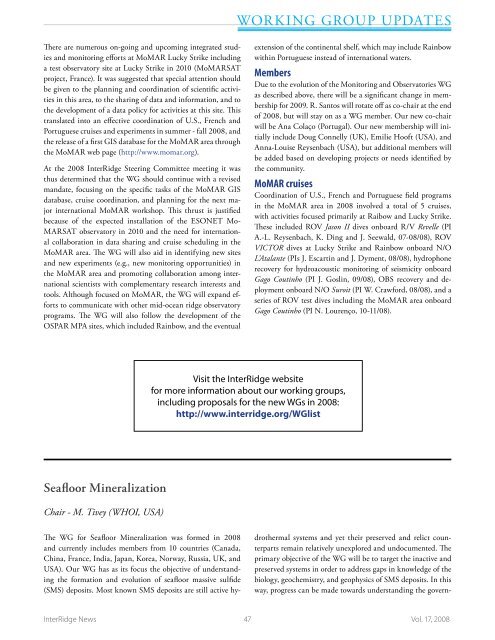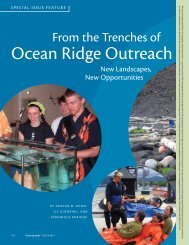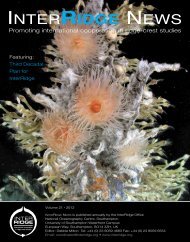Full version, lower resolution, 3.25MB - InterRidge
Full version, lower resolution, 3.25MB - InterRidge
Full version, lower resolution, 3.25MB - InterRidge
You also want an ePaper? Increase the reach of your titles
YUMPU automatically turns print PDFs into web optimized ePapers that Google loves.
Working Group Updates<br />
There are numerous on-going and upcoming integrated studies<br />
and monitoring efforts at MoMAR Lucky Strike including<br />
a test observatory site at Lucky Strike in 2010 (MoMARSAT<br />
project, France). It was suggested that special attention should<br />
be given to the planning and coordination of scientific activities<br />
in this area, to the sharing of data and information, and to<br />
the development of a data policy for activities at this site. This<br />
translated into an effective coordination of U.S., French and<br />
Portuguese cruises and experiments in summer - fall 2008, and<br />
the release of a first GIS database for the MoMAR area through<br />
the MoMAR web page (http://www.momar.org).<br />
At the 2008 <strong>InterRidge</strong> Steering Committee meeting it was<br />
thus determined that the WG should continue with a revised<br />
mandate, focusing on the specific tasks of the MoMAR GIS<br />
database, cruise coordination, and planning for the next major<br />
international MoMAR workshop. This thrust is justified<br />
because of the expected installation of the ESONET Mo-<br />
MARSAT observatory in 2010 and the need for international<br />
collaboration in data sharing and cruise scheduling in the<br />
MoMAR area. The WG will also aid in identifying new sites<br />
and new experiments (e.g., new monitoring opportunities) in<br />
the MoMAR area and promoting collaboration among international<br />
scientists with complementary research interests and<br />
tools. Although focused on MoMAR, the WG will expand efforts<br />
to communicate with other mid-ocean ridge observatory<br />
programs. The WG will also follow the development of the<br />
OSPAR MPA sites, which included Rainbow, and the eventual<br />
extension of the continental shelf, which may include Rainbow<br />
within Portuguese instead of international waters.<br />
Members<br />
Due to the evolution of the Monitoring and Observatories WG<br />
as described above, there will be a significant change in membership<br />
for 2009. R. Santos will rotate off as co-chair at the end<br />
of 2008, but will stay on as a WG member. Our new co-chair<br />
will be Ana Colaço (Portugal). Our new membership will initially<br />
include Doug Connelly (UK), Emilie Hooft (USA), and<br />
Anna-Louise Reysenbach (USA), but additional members will<br />
be added based on developing projects or needs identified by<br />
the community.<br />
MoMAR cruises<br />
Coordination of U.S., French and Portuguese field programs<br />
in the MoMAR area in 2008 involved a total of 5 cruises,<br />
with activities focused primarily at Raibow and Lucky Strike.<br />
These included ROV Jason II dives onboard R/V Revelle (PI<br />
A.-L. Reysenbach, K. Ding and J. Seewald, 07-08/08), ROV<br />
VICTOR dives at Lucky Strike and Rainbow onboard N/O<br />
L’Atalante (PIs J. Escartin and J. Dyment, 08/08), hydrophone<br />
recovery for hydroacoustic monitoring of seismicity onboard<br />
Gago Coutinho (PI J. Goslin, 09/08), OBS recovery and deployment<br />
onboard N/O Suroit (PI W. Crawford, 08/08), and a<br />
series of ROV test dives including the MoMAR area onboard<br />
Gago Coutinho (PI N. Lourenço, 10-11/08).<br />
Visit the <strong>InterRidge</strong> website<br />
for more information about our working groups,<br />
including proposals for the new WGs in 2008:<br />
http://www.interridge.org/WGlist<br />
Seafloor Mineralization<br />
Chair - M. Tivey (WHOI, USA)<br />
The WG for Seafloor Mineralization was formed in 2008<br />
and currently includes members from 10 countries (Canada,<br />
China, France, India, Japan, Korea, Norway, Russia, UK, and<br />
USA). Our WG has as its focus the objective of understanding<br />
the formation and evolution of seafloor massive sulfide<br />
(SMS) deposits. Most known SMS deposits are still active hydrothermal<br />
systems and yet their preserved and relict counterparts<br />
remain relatively unexplored and undocumented. The<br />
primary objective of the WG will be to target the inactive and<br />
preserved systems in order to address gaps in knowledge of the<br />
biology, geochemistry, and geophysics of SMS deposits. In this<br />
way, progress can be made towards understanding the govern-<br />
<strong>InterRidge</strong> News 47 Vol. 17, 2008
















